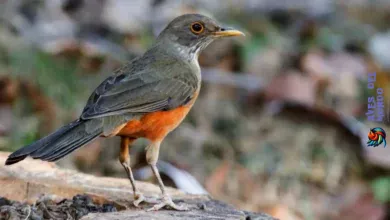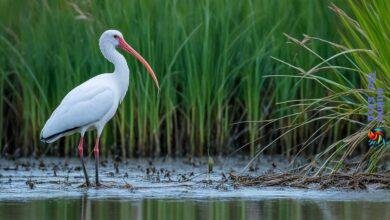Did you know the unique kiwi bird doesn’t build nests in trees? Instead, they make elaborate nests under the ground. This shows how avian nesting behavior varies with each bird. The kiwi’s choice of nesting spot is very different from most birds. It showcases the wide range of bird nesting habits.
The kiwi’s ground nests are crucial for its survival. They help the bird thrive despite tough conditions. These nests are safe places where kiwis raise their young. They’re important for the bird’s future.
The kiwi’s home is hidden below the forest floor. We invite you to discover the unique lives of these nocturnal birds. Learn how their nests play a key role in their survival. These nests help preserve a species linked closely with New Zealand’s identity.
The Unique Nesting Behaviors of Kiwi Birds
Exploring kiwi birds in their natural setting shows their amazing avian nesting behavior and bird nest ecology. These birds are not only unique in looks but in how they make their nests. Looking into their lives, you see the importance of their nest-making. It shows their skill in living on the ground.
Kiwi Birds as Ground Dwellers: Adapting to Different Environments
Kiwi birds have adapted their nesting to live on the forest floor. They nest in various places, from ancient forest moss to grassy plains. This shows how vital nests are, especially for land-dwelling birds like kiwis.
The Role of Monogamous Pairing in Kiwi Nesting
Kiwi birds usually stick with one partner for life. This is clear in their way of making nests. The female, usually bigger, picks the spot. This teamwork helps them protect their young, improving survival chances.
Construction of the Nest: Methods & Materials Used by Kiwis
Kiwis show impressive skills in building nests. They choose hidden places to dig and shape their nests with their legs and claws. Kiwi nests are like mazes, protecting them from predators and the weather. They use leaves, grass, and feathers, showing their bond with their surroundings.
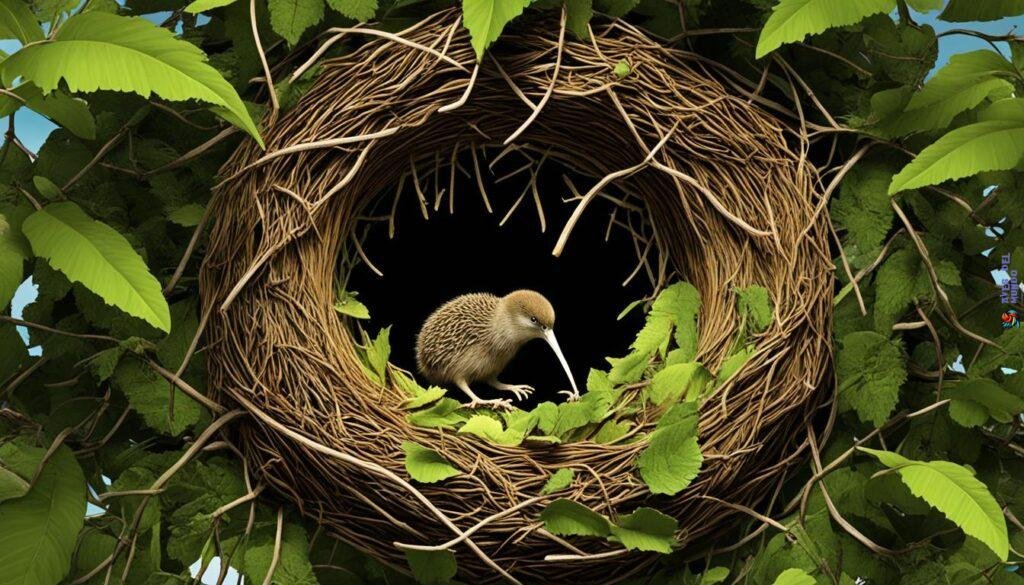
Studying kiwi birds gives insight into their nesting’s role in their lives. From working with their partners to unique nesting ways, kiwis show the adaptability needed to survive. They highlight the complex world of bird nest construction and how avian nesting behavior adapts to overcome challenges.
The Role of Nests in the Lives of Birds
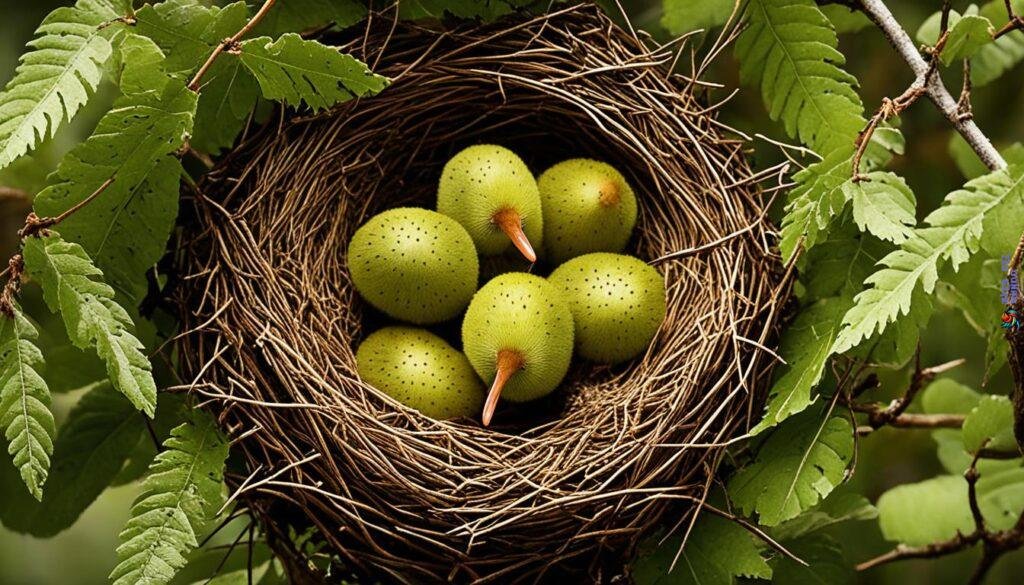
Looking into bird nest functions is like seeing into a natural incubator for birds. For birds, building nests is an instinctive skill shaped by evolution. It helps keep their species going. The importance of bird nests is big; they are crucial for the future of birds.
Bird nesting habits show many kinds of nests. Each is made to meet the bird’s needs and help it survive. From simple ground nests to elaborate ones, bird nest types show how clever birds are.
From cup-shaped nests to complex woven tapestries hanging from branches, the variety of bird nest types shows how birds adapt to survive.
Avian nesting behavior covers more than just building; it includes picking the right spot and materials. It’s not just about surviving. It’s a bonding ritual that helps bird pairs and supports the ecosystem.
- Site Selection: Birds pick places that help their young survive best. They consider food, safety from predators, and climate.
- Material Collection: Birds use many materials for nests, from twigs to human-made items. This shows their creativity and flexibility.
- Nest Construction: Building a nest is complex and often a team effort. It provides a safe space for eggs and young birds.
The importance of bird nests also shows in how they indicate environmental health. Problems with nest materials can point out bigger ecosystem issues. Understanding and protecting bird nests is vital for birds and our environment.
| Nest Type | Material Used | Function | Example Species |
|---|---|---|---|
| Platform | Sticks and large twigs | Rearing large broods | Bald Eagle |
| Cavity | Excavated wood | Protection from elements | Woodpecker |
| Pendant | Grasses and spider silk | Predator avoidance | Baltimore Oriole |
| Ground scrape | Minimal; may include pebbles or leaves | Camouflage | Plover |
| Mud nest | Mud, vegetation | Thermal regulation | Swallow |
Exploring bird nest functions and the importance of bird nests helps us learn about nature’s balance. Each nest tells a story of bird life. It’s important for us to protect these wonders for future generations.
Understanding Kiwi Territory and Mate Selection
Kiwi birds have unique habits when building nests related to their territory and finding a mate. The construction of a nest starts only after a male claims his territory. This is very important for reproduction and nesting. The way kiwis nest shows their unique life cycle and how they succeed in reproducing.
Establishing Territory: The Foundation for Nest Building
A kiwi’s territory can be as big as 100 hectares. They need this space to make a safe place for their offspring. These large territories protect against rivals and help future generations prosper. Understanding kiwi territory shows how they instinctively protect and nurture.
Securing a Mate: The Role of Calls and Duet Performances
Kiwis have an interesting way of finding and keeping a mate: vocal duets. This call helps in choosing a mate and strengthens their bond. It also shows other kiwis they are a united pair. These duets are vital in the kiwi’s life, showing the importance of nesting behavior in finding a mate.

Kiwi birds’ nesting habits are signs of their evolutionary success. While all birds claim territory and select mates, kiwis have adapted these behaviors for their special needs. This makes their way of nesting unique.
Comparison of Kiwi Nesting Habits with Other Bird Species
Exploring bird nest types is a fascinating journey. Kiwi birds stand out with their unique nesting habits. They use their natural digging skills, unlike others.
Kiwi birds create homes on the ground, in burrows. This approach gives them safety and helps their eggs stay warm. It’s different from birds that build nests up high.
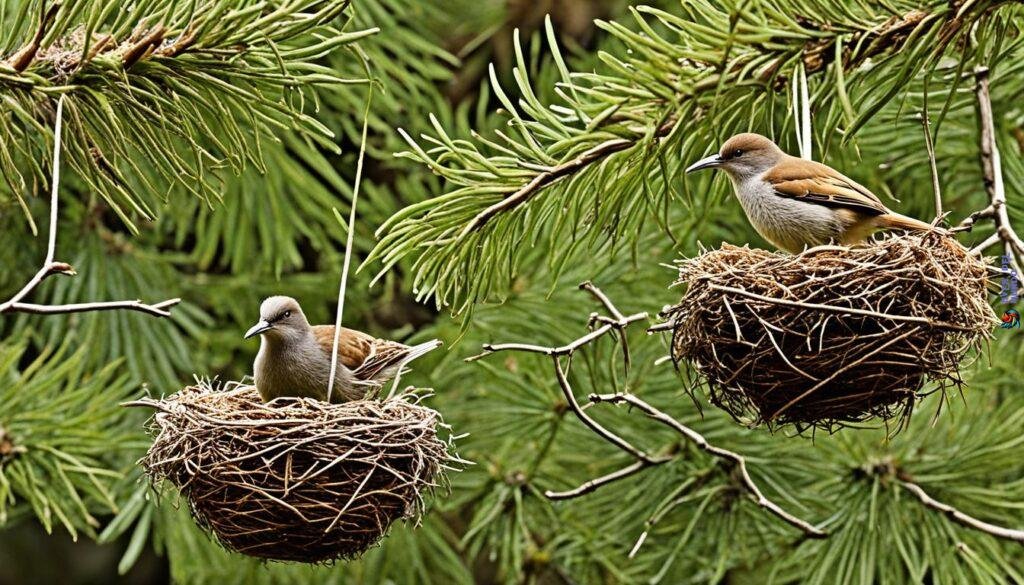
| Species | Nest Type | Location | Construction Materials | Breeding Roles |
|---|---|---|---|---|
| Kiwi Birds | Burrows | Ground | Soil, Vegetation | Male Dominantly Incubates |
| Typical Birds | Elevated Nests | Trees, Cliff-sides | Twigs, Leaves, Mud | Females Often Incubate |
| Waterfowl | Ground Nests | Near Water Bodies | Reeds, Grasses | Shared Incubation Duties |
| Sea Birds | Cliff Nests | Coastal Cliffs | Guano, Feathers | Both Parents Incubate |
Kiwis choose safety below ground with simple nests, while other birds aim high. Kiwi’s avian nesting behavior also shows a rare role reversal. Males do most of the incubation.
Learning about bird nest types makes you appreciate nature more. From kiwis to songbirds, each has a unique way to care for their young. This shows why we must protect their homes.
A Deep Dive into Kiwi Nest Construction
Looking into kiwi birds’ nest-building shows their unique bird nesting habits and avian nesting behavior. Importance of bird nests is clear when we see the special needs of these flightless birds. They are different from other bird nest types. Let’s look at what makes their building methods unique.
Material Gathering: Natural vs. Man-made Nesting Materials
Kiwis are very adaptable in bird nest construction. They use different materials for their nests. They mix natural items and sometimes man-made objects into their nests. Natural stuff like moss and leaves provide comfort and warmth for their chicks. At times, kiwis might add human trash, showing they are smart in using what’s around them.
The items kiwis gather are carefully chosen. They show a deep knowledge of their surroundings and the need for hiding and safety. Below is a table that shows the different materials kiwis like to use for their nests. It highlights the variety of their choices.
| Natural Materials | Man-made Materials |
|---|---|
| Leaves | Plastic pieces |
| Moss | Fabric scraps |
| Grass | Paper |
Nesting Burrows: Characteristics and Variations Among Kiwi
Kiwi birds don’t nest in trees. Instead, they dig burrows on the ground. These nesting burrows show the diversity in bird nest types. They vary greatly. Some are simple under bushes, others have many rooms. Kiwi birds’ nests vary because of their needs, the places they live, and challenges like predators.

The way kiwis build their nests helps them survive in New Zealand’s wilderness. Each nest is safe, a home, and a place for their young. It’s a big part of how kiwis continue as a species. Building nests connects deeply to the circle of life, showing the importance of these birds.
Kiwi Incubation Practices: A Parental Division of Labor
Exploring bird reproduction and nesting, the kiwi showcases a unique partnership. Both parents share the job, challenging old views. This teamwork is rare in the bird world, where usually females incubate.

The kiwi male grows a bare skin spot called the brood patch for warming eggs. This warmth is vital for the egg’s growth. The dedication of male kiwis during this time is so intense. They can lose a lot of weight for their future chicks.
The kiwi nest illustrates a smart survival plan. Both parents contribute to chick hatching. This is a small part of a bigger story about bird survival strategies.
By digging burrows, kiwis do more than create homes. They help us learn more about nature. The importance of bird nests goes beyond simple homes. They are key to understanding the intricate lives of birds.
The Nesting Season and Reproductive Strategies of Kiwis
Kiwi birds have a fascinating life rhythm tied to their environment, especially in reproducing. It’s crucial to understand why bird nests are important. They are more than shelters – they are where new life begins. The kiwi’s nesting season is a busy time. It reflects the changing seasons and resource availability. So, nests are essential not just for keeping eggs warm but also as a key part of bird reproduction for these special creatures.
Timing and Duration of the Kiwi Breeding Season
The breeding season of kiwi birds is remarkable for its timing. It usually goes from June to March. This period aligns with when food is plentiful, vital for mating, making nests, and warming eggs. The timing can change in different places. This shows how nests are not just for offspring. They also show how birds adapt to their environments.
Operational Nest Egg: Impact on Breeding Behaviors
Human conservation efforts, like Operation Nest Egg™, have interesting effects on kiwi breeding. Thanks to this program, kiwi birds bred in safety start families earlier than those in the wild. Operation Nest Egg™ is a push to protect kiwis from high wild mortality rates. It has led to new breeding and nesting habits among these birds, aided by human help.

The interaction between kiwi birds’ natural behaviors and human conservation shows how adaptable these birds are. These insights into breeding strategies can help shape future conservation efforts. They show a give-and-take relationship between the kiwis and humans looking after them. In the end, knowing and supporting kiwi nesting and reproductive strategies is key to their future.
Kiwi Chicks: Hatching and Early Days in the Nest
The journey of bird reproduction and nesting is fascinating. When kiwi chicks hatch, they have feathers and are ready to see the world. Their nest is more than a place; it is where they get all their food. The egg yolk feeds them, so they don’t need to find food for the first weeks.

Looking at the role of nests in the lives of birds helps us understand nature’s balance. Kiwi nests are carefully made by adult kiwis. They keep the chicks safe from dangers outside. In these nests, kiwi chicks face a tough start with high risks from predators. Their home is their safe space during this dangerous time.
Bird nesting habits show us the kiwi’s dedication to surviving from the start. However, not every chick makes it to adult life. The nest’s location and how it’s made are crucial. They show how nature’s design plays a big role in bird life.
Avian Nesting Behavior: The Ingenuity of Bird Architecture
Birds build nests to keep their young safe and warm. No other feature in their lives matches the nests’ importance. In New Zealand, birds show off a wide range of nesting styles. This variety reflects their amazing ability to adapt, which is key for their chicks’ survival.

Bird reproduction and nesting are vital. The nests must be safe and suitable for the chicks. Let’s explore how New Zealand’s birds are master nest builders.
Nest Variations Across New Zealand Avian Species
In New Zealand, birds innovate with their nests. The Grey Warbler makes tight, cobweb-filled nests. The South Island Robin uses mud to strengthen its nest. You’ll see that these nests do more than shelter. They create balanced ecosystems for raising young birds.
Implications of Loss of Habitat on Nesting and Bird Populations
Habitat loss is a big problem for birds. It changes where birds can build nests, putting them in danger. This loss affects not just the land but the traditional nesting habits birds rely on. Protecting bird populations is more crucial now than ever.
| Bird Species | Nesting Habit | Impact of Habitat Loss | Conservation Measures |
|---|---|---|---|
| Grey Warbler | Cobweb-laced spherical nests | Decreased nesting sites | Planting native trees and shrubs |
| South Island Robin | Mud-lined cup-shaped nests | Loss of undergrowth for material | Control of invasive species |
| Fiordland Penguin | Ground burrows in forested areas | Deforestation leading to exposure | Preservation of native forests |
Changing landscapes lead to more man-made nests, like birdhouses. This helps with the disrupted natural nesting habits. By understanding and taking action, we can support bird reproduction and nesting. This ensures the survival of these incredible creatures. The genius of bird architecture shows the wonder of nature.
Kiwi Birds vs. Other Birds: A Tale of Nests and Survival
Kiwi birds in New Zealand have a unique way of nesting. They don’t build nests in trees like other birds. Instead, kiwis are ground-dwellers, active at night. Their nests are hidden and strong, to protect their future generations. These cleverly concealed nests show the kiwis’ smart survival tactics.
Birds have different methods for making nests. Some choose high spots to avoid predators. Kiwi birds, however, dig burrows or find hidden places. Every bird, from the mountain kea to the beach-loving seagull, finds a nesting solution. While kiwis have underground nests, others use sticks, leaves, and mud for theirs.
Understanding nesting is key, especially with habitat loss threatening many birds. Birds must adapt to survive changes, like cities growing or their natural homes changing. The kiwi bird’s ability to adjust is vital for its survival. This shows how crucial nests are, not just for kiwis but for all birds facing survival challenges.
